In the US, 88 million adults, or 1 in 3, have prediabetes, diabetes and many are unaware of it. Prediabetes, a precursor to type 2 diabetes, features elevated levels of blood glucose that aren't high enough for a type 2 diabetes diagnosis. Lifestyle changes, such as diet and exercise, can reverse prediabetes. Left untreated, prediabetes often progressed to type 2 diabetes.
As a functional and family medicine doctor, I often address prediabetes and food management. This blog post answers frequently asked questions to help you make informed dietary choices and combat prediabetes. These are some frequently asked questions for foods and prediabetes and diabetes.
Guiding Principles for Foods and Prediabetes
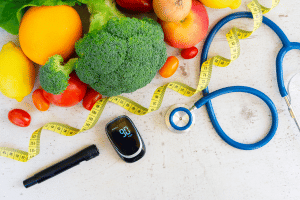
For prediabetes management, as part of your healthy lifestyle, consume a balanced diet with nutrient-dense, whole, unprocessed foods, such as whole grains, fruits and vegetables, lean proteins, healthy fats, and low-fat dairy or alternatives. These foods stabilize blood sugar, reduce inflammation, and support overall health.
Avoid or moderate intake of refined carbohydrates, added sugars, saturated and trans fats, and excessive alcohol, all risk factors, as they can cause blood glucose spikes, weight gain, and inflammation, hindering pre-diabetes reversal.
Carbohydrates are still acceptable, but choose complex carbs from unprocessed grains, fruits, vegetables, and legumes. They provide essential nutrients and sustained energy, while fiber helps regulate blood sugar.
Improve weight management by staying active and engaging in regular physical activity and being mindful of portion sizes in order to maintain a healthy weight, reverse diabetes, and prevent prediabetes. Utilize smaller plates to encourage moderate portions, accurately measure servings, and arrange your plate into sections for balanced nutrition. Attune to your body's hunger and satiety signals, and refrain from eating directly from packages to promote mindful consumption.
How often should I eat?

As a general rule, eat small, balanced meals every 3-4 hours to regulate blood glucose and prevent overeating. This typically includes three main meals and one or two healthy snacks. Consult a registered dietitian or healthcare professional to determine the best eating pattern for your needs.
Can I still enjoy my favorite treats?
Yes, but practice moderation and portion control. Maintain a healthy eating pattern most of the time while allowing occasional indulgences.
How can I make dining out or attending social events easier as a prediabetic?

Review menus beforehand, request modifications, opt for smaller portions, choose low-calorie beverages, and bring a healthy dish to share at gatherings.
Can a prediabetic eat pizza?

Prediabetics can eat pizza in moderation with mindful choices: opt for thin or whole wheat crust, load up on vegetable toppings, limit high-fat and processed meats, use moderate or lower-fat cheese, and practice portion control. Consult a healthcare professional for personalized guidance on incorporating pizza into your meal plan.
Is corn good for pre-diabetes?

Corn can be included in a prediabetic diet, but it's essential to consume it in moderation and as part of a balanced meal plan. Corn is a starchy vegetable and a source of complex carbohydrates. It contains fiber, vitamins, and minerals that can be beneficial for overall health.
However, corn has a higher glycemic index (GI) than non-starchy vegetables, which means it can cause a quicker rise in levels of blood glucose compared to other vegetables. For individuals with prediabetes, it's important to manage carbohydrate intake and distribute it evenly throughout the day to maintain stable blood sugar levels.
When incorporating corn into your diet, keep the following tips in mind:
1. Choose whole corn or corn on the cob instead of processed corn products, such as corn chips or corn-based snacks, which may be higher in calories and lower in nutrients.
2. Combine corn with non-starchy vegetables, lean protein, and fats to create a balanced meal.
3. Practice portion control. A serving size of corn is about half a cup (cooked) or one small ear of corn.
4. Opt for cooking methods like boiling, steaming, or grilling instead of frying to minimize added fats.
As with any food, moderation is key. Including corn as part of a varied diet that emphasizes whole kernal grains, lean protein, fruits, vegetables, and fats can help manage and prevent pre-diabetes effectively.
Is almond milk good for pre-diabetes?
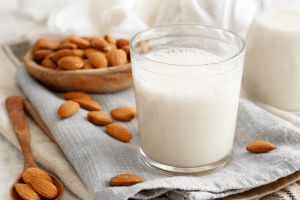
Yes, almond milk can be a good choice for individuals with prediabetes, as long as you choose unsweetened varieties. Almond milk is low in calories and carbohydrates, making it a suitable alternative to cow's milk for those looking to manage blood sugar levels and maintain a healthy body weight too.
Here are some benefits of incorporating unsweetened almond milk into a prediabetic diet:
1. Low carbohydrate content: Unsweetened almond milk contains minimal carbohydrates, which helps in managing energy levels and of blood glucose.
2. Low calorie: Almond milk is typically lower in calories compared to cow's milk, which can be beneficial for both weight loss and management. Weight control is an essential factor in reversing pre-diabetes.
3. Healthy fats: Almond milk contains monounsaturated fats, which are known to promote heart health and support blood sugar management.
4. Plant-based: As a dairy-free alternative, almond milk is suitable for those with lactose intolerance, dairy allergies, or those following a plant-based diet.
5. Fortification: Some almond milk brands are fortified with essential nutrients, such as calcium and vitamin D, which can help ensure adequate nutrient intake.
When shopping for almond milk, look for unsweetened varieties without additional sugars or artificial sweeteners. Keep in mind that almond milk is lower in protein compared to cow's milk, so be sure to include other sources of protein in your diet, such as lean meats, fish, legumes, or soy products.
In conclusion, unsweetened almond milk can be a suitable option for individuals with prediabetes, as it is low in carbohydrates and calories, making it a valuable addition to a balanced diet.
What are the best prediabetic diet Indian food choices?

A prediabetic diet should focus on managing levels of blood glucose, promoting weight loss (if needed), and reducing the other risk factors of developing type 2 diabetes. In the context of Indian cuisine, this means incorporating foods that are high in fiber, low in refined carbohydrates, and rich in nutrients. Here are some suggestions for Indian food choices that can be suitable for a prediabetic diet:
1. Whole grains: Opt for unprocessed grains like brown rice, whole wheat, quinoa, or millets instead of refined grains like white rice or white flour (maida). These whole unprocessed grains have a lower glycemic index, which can help manage blood sugar levels.
2. Legumes and pulses: Lentils, chickpeas, and beans are excellent sources of protein and fiber. They can be used to prepare dishes like dals, rajma, and chana masala.
3. Vegetables: Include a variety of non-starchy vegetables such as spinach, cauliflower, cabbage, bell peppers, and green beans in dishes like sabzis, stir-fries, or salads.
4. Lean proteins: Choose lean protein sources like chicken, fish, or tofu. These can be incorporated into dishes like grilled tikkas, kebabs, or curries made with low-fat yogurt or tomato-based sauces.
5. Low-fat dairy: Opt for low-fat yogurt, milk, or paneer to help reduce overall calorie and fat intake.
6. Healthy fats: Use fats like olive oil, mustard oil, or ghee in moderation for cooking. Include nuts, seeds, and avocados in your diet as well.
7. Spices and herbs: Indian cuisine is rich in spices and herbs, which can have antioxidant and anti-inflammatory properties. Use spices like turmeric, cinnamon, fenugreek, and cumin to add flavor without extra calories.
8. Portion control: Be mindful of portion sizes, especially when consuming carbohydrate more sugar-rich foods like rice, roti, or paratha. This can help prevent high blood pressure and glucose spikes.
9. Limit sugary beverages and sweets: Cut down on sweetened drinks and desserts, opting for fresh fruits or small portions of healthier alternatives like kheer made with low-fat milk and natural sweeteners.
10. Balanced meals: Ensure your meals have a balance of protein, fats, and complex carbohydrates to promote better blood sugar control body, weight loss, and overall good health.
What is the best wine for pre-diabetes?

If you have concerns about your alcohol consumption, it is always best to consult a healthcare professional.
Moderate alcohol consumption may be acceptable for people with pre-diabetes, but it is essential to monitor the impact on levels of blood glucose and overall better health. When choosing wine, it is generally advised to opt for options with lower sugar and carbohydrate content.
Dry wines tend to have lower sugar content compared to sweet wines. Some examples of wines that typically have lower sugar content include:
1. Dry red wines: Cabernet Sauvignon, Pinot Noir, and Merlot
2. Dry white wines: Sauvignon Blanc, Chardonnay, and Pinot Grigio
3. Brut sparkling wines: Champagne, Prosecco, and Cava
It is crucial to keep in mind that alcohol can affect heart disease, high blood pressure and sugar levels and should be consumed in moderation.
Is guava good for pre-diabetes?

Yes, guava is a good fruit option for individuals with diabetes or prediabetes. Guava is a nutrient-dense fruit that offers several health benefits, making it a valuable addition to a balanced diet aimed at managing blood sugar levels.
Here are some reasons why guava can be beneficial for pre-diabetes:
1. Low glycemic index (GI): Guava has a low glycemic index, meaning it causes a slower and more gradual rise in blood sugars compared to high-GI foods. This characteristic makes it a suitable fruit choice for those with prediabetes.
2. High in fiber: Guava is rich in dietary fiber, which can help regulate levels of blood glucose, support digestion, and contribute to feelings of fullness more energy. Consuming fiber-rich foods can help with weight management, which is crucial early treatment and for reversing prediabetes.
3. Rich in nutrients: Guava is an excellent source of vitamin C, vitamin A, potassium, and other essential nutrients. These nutrients contribute to overall health and can help support immune function and heart health.
4. Antioxidant properties: Guava contains antioxidants, such as lycopene and quercetin, which help combat oxidative stress and may reduce inflammation in the body. Chronic inflammation is a contributing factor to insulin resistance, so consuming antioxidant-rich foods can be beneficial for managing prediabetes.
When incorporating guava into your prediabetic diet, remember to practice portion control and balance it with other food groups, such as unrefined grains, lean proteins, and fats. Including guava as part of a varied, nutrient-dense diet can help manage pre-diabetes effectively.
Are grapes good for pre-diabetes?

Grapes, like other fruits, contain natural sugars, vitamins, minerals, and fiber, which can be part of a healthy diet. For people with prediabetes, it's essential to manage carbohydrate intake and maintain a balanced diet to prevent the progression to type 2 diabetes.
While grapes can be included in a pre-diabetes-friendly diet, portion control is important. Consuming excessive amounts of grapes or any fruit could lead to an increase in levels of blood glucose, which is not ideal for someone with pre-diabetes.
It's typically recommended to choose low glycemic index (GI) fruits, such as berries, cherries, or apples, which have a slower impact on blood sugar levels. However, this doesn't mean that you cannot eat grapes – just be mindful of portion sizes and balance them with other low-GI foods.
Are oranges good for prediabetes?

Oranges can be a part of a healthy diet for individuals with prediabetes, as they contain essential nutrients, such as vitamin C, potassium, and dietary fiber. However, like with any fruit, portion control and moderation are key. Oranges contain natural sugars and carbohydrates, which can impact blood sugar levels.
In general, fruits with a lower glycemic index (GI) are considered better for managing blood sugars, as they cause a slower and more gradual increase in blood glucose. Oranges have a moderate GI, which means they can be included in a prediabetes-friendly diet if consumed in appropriate amounts and balanced with other low-GI foods.
Is peanut butter good for pre-diabetes?
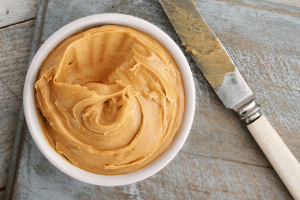
Peanut butter can be a part of a healthy diet for individuals with diabetes or prediabetes when consumed in moderation. Peanut butter is a source of fats, protein, and fiber, which can help with satiety and blood sugar management. However, portion control is crucial, as peanut butter is calorie-dense and can contribute to weight gain if consumed in excessive amounts.
When selecting peanut butter, it's important to choose a variety without additional sugars, as some peanut butter products contain added sweeteners that can increase the overall carbohydrate content and impact levels of blood glucose. Opt for natural peanut butter made from just peanuts and, perhaps, a small amount of salt.
Including peanut butter in a balanced diet, along with other nutrient-dense foods, can be beneficial for individuals with pre-diabetes.
Is coffee good for pre-diabetes?

Research on the effects of coffee consumption for individuals with prediabetes is mixed. Some studies suggest that moderate coffee consumption may have potential benefits in reducing the various risk factors of developing type 2 diabetes, while others show neutral or inconclusive results.
Some possible benefits of coffee consumption include:
1. Antioxidants: Coffee is a source of antioxidants, which may help fight inflammation and protect cells from damage.
2. Improved insulin sensitivity: Some studies have found that moderate coffee consumption may improve insulin sensitivity, which could be beneficial for prediabetes management.
However, there are also some considerations to keep in mind:
1. Caffeine: Caffeine, a stimulant found in coffee, can cause a temporary increase in blood glucose levels and may reduce insulin sensitivity in some individuals with diabetes. The effects of caffeine on diabetes can vary from person to person.
2. Added sugars and creamers: Adding sweeteners, syrups, or high-fat creamers to your coffee can significantly increase its calorie and sugar content, which is not ideal for prediabetes management.
If you have prediabetes and choose to consume coffee, it's best to opt for black coffee or coffee with minimal additional sugars and creamers. It's also important to consider how your body reacts to caffeine and adjust your consumption accordingly.
Is dark chocolate good for pre-diabetes?

Dark chocolate, when consumed in moderation, may offer some health benefits for both diabetic people or with pre-diabetes. Dark chocolate contains antioxidants, specifically flavonoids, which can help improve insulin sensitivity, reduce inflammation, keep weight, and support heart health. It is important to choose dark chocolate with a high cocoa content (at least 70% cocoa) to maximize these potential benefits and minimize extra sugars.
However, moderation is key, as chocolate can be high in calories and fat, which may contribute to weight gain if consumed in excess. Weight management is an essential aspect of managing prediabetes, as it can help to prevent diabetes and the progression to type 2 diabetes.
When incorporating dark chocolate into your diet, opt for small portions, such as one or two squares, and choose a brand with minimal additional sugars. Also, be mindful of your overall daily sugar and calorie intake.
Are eggs good for pre-diabetes?

Eggs are generally considered a healthy food choice for people with prediabetes or type 2 diabetes. They are a good source of high-quality protein, fats, vitamins, and minerals. Protein helps with blood glucose regulation by slowing the absorption of carbohydrates, which can help prevent blood sugar spikes.
Additionally, how you prepare eggs can impact their overall healthiness. Boiling or poaching eggs are healthier options compared to frying them in butter or oil. Including vegetables in your egg-based meals can also be beneficial for pre-diabetes, as they provide essential nutrients and fiber.
As a prediabetic, can I eat rice, noodles, bread, and congee?
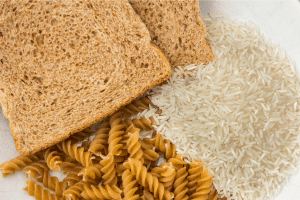
As a pre-diabetic, you can still enjoy rice, noodles, white bread, and congee, but it's essential to make these healthier lifestyle choices, practice portion control, and balance these carbohydrate-rich foods with protein, fats, and non-starchy vegetables to help manage low blood sugar and levels effectively.
Here are some tips for incorporating these foods into your pre-diabetic diet:
1. Rice: Choose whole grain rice varieties, such as brown rice, red rice, or black rice, which are higher in fiber and nutrients compared to white rice. Opt for a smaller portion size (about 1/3 to 1/2 cup cooked) and combine it with lean protein and non-starchy vegetables.
2. Noodles: Opt for whole grain or high-fiber noodle options, such as whole wheat noodles, soba noodles (buckwheat), or shirataki noodles. Pair them with lean protein sources (e.g., chicken, fish, tofu) and non-starchy vegetables to create a balanced meal.
3. Bread: Choose whole grain bread with a higher fiber content. Look for bread made from whole wheat flour, whole rye flour, or other whole kernal grains. Limit portion sizes to 1-2 slices per meal and pair bread with lean protein, fats, and non-starchy vegetables.
4. Congee: Congee, a rice porridge, can be made with whole grain rice like brown rice to increase its fiber content. Add lean protein, such as shredded chicken or turkey, and non-starchy vegetables to create a more balanced and nutritious meal. Pay attention to portion sizes, as congee can be relatively high in carbohydrates due to the rice content.
Recommendations for Limiting Sugar in a Prediabetic?

It's important for individuals with type 2 diabetes or pre-diabetes to manage their sugar intake to help prevent the progression to type 2 diabetes and maintain overall health. Here are some recommendations for limiting sugar consumption in type 2 diabetes:
1. Be aware of additional sugars: - Read labels and food labels to check for additional sugars in products. Additional sugars can come from processed foods in various forms, such as high fructose corn syrup, sucrose, glucose, maltose, and more. Limit foods and drinks that contain high amounts of extra sugars.
2. Choose whole, unprocessed foods: Consume whole, unprocessed foods, such as fresh fruits, vegetables, lean proteins, and whole unrefined grains. These foods typically have a lower glycemic index and provide essential nutrients without extra sugars.
3. Limit on sugary foods and beverages: Avoid or minimize the consumption of sugar-sweetened beverages, such as soda, fruit juices, and energy drinks. Instead, opt for water, unsweetened tea, or coffee without added sugars.
4. Replace sweets with healthier alternatives: When craving something sweet, choose a healthier alternative, such as fresh fruit, yogurt with no added sugar, or a small serving of nuts.
5. Reduce portion sizes: When consuming foods with added sugars, try to limit portion sizes to reduce overall sugar intake.
6. Use natural sweeteners sparingly: If you need to sweeten your food or beverages, consider using natural sweeteners like stevia, erythritol, or xylitol in moderation. However, it's essential to note that these sweeteners may still have an impact on blood sugar levels, so use them sparingly.
7. Cook at home: Prepare meals at home, where you have control over ingredients and can limit the use of added sugars.
8. Focus on low glycemic index foods: Foods with a low glycemic index (GI) cause a slower, more gradual rise in levels of blood glucose, which can help manage your levels. Incorporate low-GI foods like whole unrefined grains, legumes, non-starchy vegetables, and some fruits into your diet.
9. Practice mindful eating: Eat slowly, and pay attention to hunger increased thirst, and fullness cues. This exercise can help prevent overeating, lose weight, and reduce overall sugar consumption.
What fruits should I avoid with pre-diabetes?

While fruits are generally healthy and provide essential nutrients, some fruits have a higher sugar content and can impact blood sugars more significantly. As a person with prediabetes, you don't necessarily need to avoid any fruits completely, but it's essential to be mindful of portion sizes and choose fruits with lower glycemic index (GI) values when possible.
Here are some guidelines to help you make better fruit choices:
1. Prioritize low-GI fruits: These fruits have a less significant impact on blood sugar levels. Examples include berries (e.g., strawberries, blueberries, blackberries, raspberries), cherries, apples, pears, oranges, grapefruits, plums, and peaches.
2. Limit high-GI fruits: These fruits can cause a higher risk more rapid increase in levels of blood glucose. Examples include pineapple, watermelon, ripe bananas, and ripe mangoes. You don't need to eliminate these fruits, but consume them in moderation and balance them with other low-GI foods.
3. Be cautious with dried fruits: Dried fruits, like raisins, apricots, and dates, are more concentrated in sugar and can lead to a quicker rise in blood glucose levels. Stick to small portion sizes (e.g., 2 tablespoons) and pair them with a source of protein or healthy fat to slow down digestion.
4. Avoid fruit juices and canned fruits in syrup: Fruit juices and canned fruits in syrup are high in sugar and lack the fiber found in whole fruits. Choose whole fruits instead or opt for canned fruits packed in water or natural fruit juice only. Frozen fruits are very convenient and no different from fresh fruit nutritionally.
5. Monitor portion sizes: Even healthy fruits can impact levels of blood glucose when consumed in large quantities. Aim for a serving size of about 1/2 cup of chopped fruit, one small fruit (e.g., an apple, orange, or peach), or a handful of berries.
Remember, balance and moderation are key when incorporating fruits into a prediabetic diet. By choosing lower-GI fruits, monitoring portion sizes, and combining fruits with other nutrient-dense foods, you can enjoy the benefits of fruits while managing your blood glucose effectively.
Why are whole unrefined grains considered healthy for a pre-diabetic?
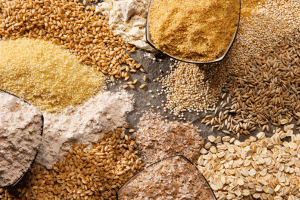
Whole unprocessed grains are considered healthy for people with pre-diabetes for several reasons:
1. High in fiber: Whole unprocessed grains are rich in dietary fiber, which can help slow the absorption of sugar into the bloodstream. This can help regulate levels of blood glucose and prevent spikes that could worsen pre-diabetes.
2. Low glycemic index (GI): Whole unrefined grains generally have a lower glycemic index compared to refined grains. Foods with a low glycemic index release glucose slowly and steadily into the bloodstream, which can help maintain better blood glucose control.
3. Nutrient-dense: Whole unprocessed grains are packed with essential nutrients, including vitamins, minerals, and antioxidants that are necessary for overall better health. They contain B vitamins, iron, magnesium, and selenium, which all play a role in maintaining proper metabolic function and insulin sensitivity.
4. Improved insulin sensitivity: Some studies suggest that consuming whole grains can help improve insulin sensitivity, which is essential for proper blood glucose regulation. Improved insulin sensitivity can lower the risk of developing type 2 diabetes.
5. Weight management: Whole grains can help with body weight management, as they tend to be more filling due to their fiber content. This can help with portion control and reduce the overall calorie intake, which is crucial for managing prediabetes and reducing the risk of developing type 2 diabetes.
Examples of whole grains include whole wheat, brown whole grain rice, quinoa, barley, oats, bulgur, and millet. It's important to incorporate a variety of whole grains into your diet for optimal health benefits.
However, it's always best to consult with a healthcare professional or a registered dietitian for personalized advice on diet and nutrition when managing prediabetes. They can give nutritional supplements and help you create a balanced meal plan that includes whole grains and other essential nutrients tailored to your specific needs.
What are the healthiest fats for a prediabetic?
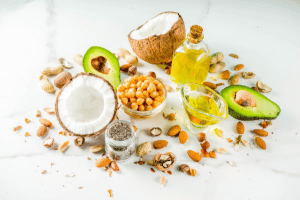
Fats can be an important part of a balanced diet for people with prediabetes, as they can help regulate blood glucose levels and reduce the risk of developing type 2 diabetes. Here are some sources of fats that are generally recommended:
1. Monounsaturated fats: These fats can help improve blood cholesterol levels and maintain insulin sensitivity. Some good sources of monounsaturated fats include:
- Avocado
- Nuts (almonds, peanuts, cashews, and macadamia nuts)
- Seeds (such as chia, flax, and pumpkin seeds)
- Olive oil
- Canola oil
2. Polyunsaturated fats: These fats can also help improve blood cholesterol levels and reduce inflammation. Omega-3 and omega-6 fatty acids are types of polyunsaturated fats that are essential for overall better health. Some good sources of polyunsaturated fats include:
- Fatty fish (such as salmon, mackerel, sardines, and trout)
- Walnuts
- Flaxseeds and flaxseed oil
- Chia seeds
- Sunflower seeds
- Soybean oil
- Corn oil
It's also essential to limit unhealthy fats, such as saturated fats and trans fats, which can negatively impact blood cholesterol levels and increase the risk of heart disease. Saturated fats are found in animal products like fatty meats, full-fat dairy products, and butter, while trans fats are mainly found in processed foods containing partially hydrogenated oils.needs.
Conclusion
Managing pre-diabetes through diet and healthy lifestyle changes is a powerful strategy for preventing the progression to type 2 diabetes. By focusing on whole, nutrient-dense foods, practicing portion control, and engaging in regular physical activity, you can take charge of your health and beat prediabetes. Remember, knowledge is power, and knowing what you eat can help you beat prediabetes for good!


